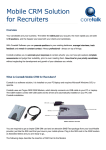Download XT-300 User Manual
Transcript
XT-300 USER GUIDE XtremeTrakGPS XT-300 User Guide 2 XT-300 USER GUIDE INTRODUCTION Thank you for purchasing the XtremeTrakGPS XT-300 battery-powered live GPS tracking device! The XT-300 is one of the most technologically advanced battery-operated GPS tracking device on the market, providing location updates every 20 feet when walking (speed less than 10mph) or every 10 seconds if the speed exceeds 10mph. The truly LIVE tracking methods employed by the XT-300 enable it to perform under a wide variety of applications, providing GPS tracking for everyone from Alzheimer’s patients to athletes (cyclists and runners), from toddlers to teens, from freight shipments to airport luggage. The applications for the XT-300 are limited only by the human imagination. Options for the XT-300 GPS tracking unit include extended-life battery kits providing up to 75 hours of actual movement on a single charge. We offer runners’ and cyclists’ pouches for tracking athletic events such as cycling circuits and marathons, and even magnetic weather-resistant boxes enabling covert placement under a vehicle. Not surprisingly, the XT-300 has garnered rave product reviews in the press. GPS Magazine calls it “The most accurate, easy to use GPS Tracker available.” It’s a testament to our staff and their dedication to design and build nothing less than the best product of its kind on the market, without exception. At XtremeTrakGPS, we go to extremes to deliver a world-class product, and are equally dedicated delivering of a comparably world-class customer service experience. XtremeTrakGPS XT-300 User Guide Figure 3.0 XT-300 Live Tracker For this reason, LIVE support is embedded directly into our tracking system. If you encounter difficulties, have additional questions, or simply want to say “job well done”, we’re always delighted to hear from you. Use common sense when cleaning your XT-300 – use a soft damp cloth, do not use solvents or alcohol-based cleaning agents. The XT-300 is not waterproof, so don’t submerge it in water. And the housing - like any plastic - can melt under extreme heat, so don’t subject it to environments where temperatures exceed 160°F. Given proper care, your XT-300 GPS Tracking device will provide reliable service for years to come. Thank you for choosing the XT-300. We sincerely appreciate your business! 3 XT-300 USER GUIDE DEVICE ACTIVATION Your XT-300 tracking service needs to be activated prior to use. To activate, simply call us at 405-749-1105 between the hours of 7am-7pm Monday through Friday, and 9am-5pm on Saturday. Once your device has been activated, it can take between 2-3 hours for it to start transmitting. If you wish to cancel your service, simply contact us before the 25th of the month. BATTERY CONSIDERATIONS The single biggest dilemma confronting a batteryoperated product of this nature is managing the delicate balance between battery life and update performance. Everyone wants the fastest update possible so they can see the device as it moves in real-time. The problem is that faster updates utilize more battery, and packing additional battery into a device increases cost, weight, and size. Other products on the market are comparatively primitive, solving the battery dilemma by providing 2-minute, 5-minute, or even 15-minute updates. Some are even “ping” based, updating their location only when you specifically ask for it. The problem with such slow updates is that they cannot provide an historical playback to enable you to see (with any degree of accuracy) where the GPS tracking device has been. Conversely, the XT-300 provides real-time 10-second updates, recording history for later playback so that you can see everywhere the device has been – even if you weren’t watching at the time. We balance the need for long battery life by embedding an on-board motion XtremeTrakGPS XT-300 User Guide sensor, enabling the device to power off and conserve power after 120 seconds of no movement. The instant the device moves, it powers back up, reconnects, and resumes transmission. Using this method, the XT-300 doesn’t last “X” number of hours after a charge. Rather, it lasts 8 to 10 of actual movement time with the standard battery. If a device on a vehicle moves 1 hour per day, the battery will last approximately 8-10 days on a single battery charge. If it moves 2 hours per day, the battery will last roughly 4-5 days. If it moves nonstop, it will last between 8 and 10 hours. Bearing this in mind, we must also mention that the motion sensor is incredibly sensitive to vibration – even a passing vehicle may vibrate the vehicle on which the XT-300 is installed enough to wake it. Under normal circumstances this isn’t a problem, as the XT-300 will go back to sleep after 120 seconds of no movement, but if the vehicle is parked on a busy street it can lead to a dramatically reduced operating period for that specific battery charge. For extended tracking, an extended battery kit is available to extend the battery life to up to 75 total hours of movement. With the extended battery, and driving approximately 1 hour per day, the extended battery would last about 75 days on a single charge. WEB TRACKING INTERFACE In order to access the live tracking features of the XT-300, simply load your web browser on your PC (or Mac) and go to http://live.xtremetrakgps.com. Make sure to have your login details handy that you received during your device activation. To enter your information, look for the login box, as shown on the next page in Figure 5.0. 4 XT-300 USER GUIDE and the speed at which the vehicle is traveling. The location(s) of your vehicle(s) on the map are updated every 10 seconds. Figure 5.0 Web Interface Login In the Authorization Tab on the left side of the screen, enter your login ID and password you selected during activation, then click the LOGIN button. Once login is complete, the map will immediately jump to your area and the location of your vehicle(s). You may move your mouse over the vehicle to show specific information about the vehicle such as latitude, longitude, You may move the map within the browser by clicking on the map, holding the mouse button down, and dragging the map. Double-click on an area to zoom in on it, or roll the wheel on the back of your mouse to zoom in and out on the center of the map. Clicking on a vehicle marker (not the flag, but the vehicle marker itself) will open a a “Device Options” window (Figure 6.0, next page) which gives you the ability to change the vehicle marker, change the name on the flag, change the color of the flag or flag text color, retrieve the address of the vehicle’s current location, or auto-center (follow) the vehicle. To change the vehicle marker, click on the vehicle marker image below the save button. A window will appear giving a selection of different vehicle icons you may use. To change the text which appears on the flag, simply change the text in the field labeled FLAG TEXT. You may change the color of the flag or text by clicking the COLOR button to the right of each field, respectively. When you’ve finished making your changes to the flag color, text color, flag text or vehicle marker, simply click the SAVE button. The phone driver feature is available with paid access to the SKYPE network, allowing you to phone the driver through your PC. Other options listed are not applicable to the XT-300, such as locking and unlocking doors, enabling and disabling the starter, honking the horn, and remote starting the vehicle - these are available only with hard-wired devices which must be physically wired under the dash of the vehicle to perform these functions (such as the XtremeTrakGPS XT-100 or XT-200), thus do not apply to a battery-operated device like the XT-300. Figure 5.1 GPS Tracking Web Interface XtremeTrakGPS XT-300 User Guide 5 XT-300 USER GUIDE area. In larger metro areas, high-resolution aerial images (also known as Bird’s Eye images) are available; in more rural areas, even Hybrid view may not provide the same level of detail as larger metro areas. If you live in a rural area, you may find it more useful to select “Map View” in lieu of Hybrid or Bird’s Eye view. Figure 6.0 GPS Device Options CONTROL PANEL On the left side of the map screen you will find a Control Panel, providing tabs for Authorization, Map Control, Vehicles, Reports, Alert System, Search, Directions and Routing, Address Markers, Live Support, and Historical Playback. Clicking on any of these tabs will provide access to each group of functions. This control panel is the key to all functions and features of the web-based tracking system. Through it the system provides access to reports, alerts, live support, 90-day historical playback and an unending array of other features – with more new features constantly being added. MAP CONTROL TAB You may select the “Map Control” tab from the control panel to the left, and the map control panel will open, providing controls to zoom, pan, and set map rendering options. The XtremeTrakGPS system relies on Microsoft Virtual Earth Maps to provide mapping of the coverage XtremeTrakGPS XT-300 User Guide Figure 6.1 Map Control Interface When fully zoomed, the maps provide detailed streetlevel information, enabling you to see the precise location from which your XT-300 tracking device is transmitting. When zoomed out completely, you have a complete view of the world. If you have only one device, the “Center Map” checkbox will automatically center the map on that unit. If you have multiple devices, “Center Map” will position the center of the group of devices at the center of the browser. If you select a single vehicle (under the vehicles tab), the “Center Map” checkbox will tell the system to center on the selected vehicle. “Optimize Zoom” will zoom as closely as possible while still keeping the device or group of devices on the viewable map at 6 XT-300 USER GUIDE once. “Show Traffic” will show traffic flow and congestion levels over major interstates and highways. Measured areas will be highlighted in green for normal traffic flow. Areas experiencing moderate slow-downs in traffic flow will be highlighted in yellow, and areas with major traffic snarls will be highlighted in red. Areas highlighted in black indicate complete blockages and traffic at an absolute standstill. By default, your login will show ALL the devices associated with your account – up to a maximum of 512 units on screen at once. In viewing all vehicles, you manually control the area of the map you wish to view by using the zoom and pan features to move the map within the view port. Clicking the Map View button will show a simple view of the map. Satellite will show satellite imagery. Hybrid combines the most useful features of both Map and Satellite views, superimposing street lines and names over the top of the Satellite imagery. The N, S, E or W setting allows you to select between four different angles to view Birds’ Eye imagery for a better indication of surrounding terrain. In order to select an individual vehicle, you may select the “Vehicles” tab from the control panel, and select a specific vehicle from the dropdown list. TRACKING OPTIONS Selecting a single vehicle from the dropdown list on the VEHICLES tab enables you to turn all other markers off, enabling quick isolation of the target from among a large fleet of vehicles. This feature is often used in conjunction with the “center map” checkbox on the map control to “follow” a vehicle wherever it goes. Individual vehicle selection is also used to specify which specific vehicle to replay under the historical playback control. Specifying a single vehicle to track has implications under a number of different controls. Check each section of the manual XtremeTrakGPS XT-300 User Guide for the impact of individual vehicle selection on each function. REPORTS Currently there are 20 different report options available. More reports are being added regularly. There are two types of reports – online reports which appear onscreen, and offline (Excel) reports which are emailed to the address you specify. Some reports - such as the vehicle mileage by state report or vehicle operating report – are available only via email largely due to the time required to generate the report. Another major difference between online reports and offline reports is the fact that an online report is typically run for a single vehicle for a single day. Offline reports can be run for ALL your vehicles for a period of several months. Note: When you request an offline report for multiple vehicles, bear in mind the ramifications of your request. An Excel spreadsheet only supports a maximum of 65,535 rows. If you have more data over a period of several months than can fit in 65,535 rows, the report will be truncated at row 65535. When a report is selected from the Reports control, a semi-transparent overlay appears on the map. Note that the device markers continue to move, always reflecting their locations on the map beneath. On this reports overlay, you may select the specific parameters used for the selected report. When reading a report, you will typically see a series of dates/timestamps, along with the physical address (or lat/lon, if the vehicle is continuing on a more-or-less straight course), as well as vehicle speed and heading. Headings are expressed in the range of 0 – 359, indicating thedirection in which the vehicle is pointing. Zero is north; the value increments clockwise. Reports may be highlighted and copied/pasted into Excel spreadsheets. 7 XT-300 USER GUIDE while the Alert Notification Editor is open. An Alert Zone can be as small as a driveway, or as large as an entire continent. Note: While an Alert Zone can be as small as a driveway, the functionality of an Alert Zone depends on the device making one transmission on one side of the box, and a second transmission on the opposite side (inside vs. outside). Select the notification method that you prefer. Figure 8.0 Reporting Interface TEXT AND EMAIL ALERTS Imagine, for a moment, that you’re a homebuilder, HVAC installation contractor, electrical or plumbing contractor. You want to know what time your guys are arriving on the job site each morning…. and what time they leave in the afternoon. With the Zone Alert feature of the US Fleet Tracking system, you can easily define an unlimited number of “Alert Zones” (also known as “geo-fences”) and the system will automatically notify you – by e-mail or SMS text message (or both) – any time one of your vehicles enters or exits the zones you define. Defining Alert Zones couldn’t be easier. First, zoom in on the area in which you want to create a zone notification. From here, it’s as simple as clicking the Alert System tab on the Control Panel and selecting the option to “Show Alert Editor”. A window similar to that shown in Figure 8.1 (right) will appear at the bottom of your screen. Click the “Add Zone Alert” button. In the first field, select a name for your zone, and then click and drag the pushpins at each corner of the highlighted zone on the screen. Figure 8.1 Geo-Fence Alert Settings You can have XtremeTrakGPS send an SMS text message to your cell phone, or e-mail to any address you specify. When you’ve finished specifying the e-mail address or SMS address, simply click the option to “Save Alert Zone”, and the zone you’ve created will be added to the list at the left. It’s that easy! It’s possible to draw a zone so small that the device is unlikely to make a transmission from within the defined area. When in doubt, to increase reliability of Alert Zone notifications, it is recommended that you make the box larger than the simple edges of a driveway. A area of 100 feet square is the recommended minimum size. You may roll the wheel on the back of the mouse to zoom in or out on the map, or click and drag to move the map XtremeTrakGPS XT-300 User Guide 8 XT-300 USER GUIDE Note: SMS addresses are like email addresses. Some wireless carriers define their SMS addresses as 1 + areacode + cellnumber@[yourcarrier.com] (e.g. [email protected]). Others do not recognize the address if there exists a 1 before the area code. If your SMS alerts are not arriving at your cell phone, try changing the SMS address without the 1 and saving the change to see if it makes a difference. SEARCH The “Search” feature enables the user to find locations of selected subjects within a certain area. For instance, if you were to type in “pizza” or “gas stations” in the “Find” window pushpins would populate on the map of the closest locations that matched your search criteria. With a correctly defined zone, you receive notification anytime a vehicle enters or exits the area you’ve specified. The Speed Alert is a close relative of the Zone Alert. Speed Alert enables you to define speeds at which you are notified. Speeds (like Alert Zones) can be defined for specific vehicles, or for every vehicle in your fleet. Any time one of the specified vehicles exceeds the defined speed; the XtremeTrakGPS system will notify you with an SMS text message to your cell phone, an e-mail, or both. From the same Alert Editor window, select the option to “Add Speed Alert”. Specify a name for your alert (so that you can find it later in the list at the left), and select whether you want the alert to apply to all vehicles or a specific vehicle by selecting a vehicle from the dropdown list. Fill in the speed in the next field, and you’re almost finished. Check the appropriate box and populate the fields for SMS text message or e-mail notifications (depending on the method you prefer), and select the option to “Save Speed Alert”. You’ll see your alert added to the list box at the left. Alerts are easily removed by selecting the items in the Alerts list on the left side of the Alert Editor Window and clicking the “Remove” button. When you are finished creating or editing Alert Zones and Speed Alerts, click the [X] at the upper right corner of the Alert Editor Window to close it and resume normal operation. XtremeTrakGPS XT-300 User Guide Figure 9.0 Local Search Results for “Gas” A “Search Results” box will open on the right side of your screen (See Figure 9.0) with addresses and phone numbers for the locations appearing on the screen. In the simplest of terms, if it is in the phone book, the XtremeTrakGPS tracking system will show it to you on the map. DIRECTIONS AND ROUTING Directions and Routing The “Directions and Routing” feature enables the user to enter a start and stop address, along with up to 20 additional stops on a route. The system will plot the route with driving directions. By default, “no optimization” is checked. This will show the route in the order in which the stops were entered. Note: Popups must be enabled on your browser in order to receive driving directions. Most browsers (IE, FireFox, 9 XT-300 USER GUIDE Safari, Chrome, etc.) allow you to enable popups from our site specifically while continuing to block popups from unwanted sites. If the checkbox is turned on for “Fastest Time”, the route will be optimized and the stops reordered in such a manner as to allow the driver to complete all stops in the shortest amount of time. If the checkbox is turned on for “Shortest Distance”, the route will be optimized and the stops reordered in such a manner to allow the driver to complete all stops with the lowest possible mileage. Please note that the shortest mileage is not always the fastest time – for example, interstate travel might predicate slightly higher mileage, but also higher speed and thus shortest time. In order to receive driving directions, the popup blocker on your browser may need to be disabled temporarily to enable the pop-up window with driving directions to appear. ADDRESS MARKERS The Address Markers tab exists to enable the placement of user-defined markers on the map. These markers can provide quick and easy location of warehouses, offices, and other landmarks relevant to your daily use of the US Fleet Tracking vehicle tracking system. To access this feature, select the “Address Markers” tab and click “Show Address Editor”. After typing the name you wish to appear on the marker label, type the address into the address field and click the “Find Lat:Lon” button. The system will find the closest match in the database and populate the latitude and longitude with that location. Alternatively, if you know the latitude and longitude (based on the position of a vehicle), you can simply type the latitude and longitude and click the “Find Street Address” button. To place the marker on the map, click the “Add Address” button at the lower right corner of XtremeTrakGPS XT-300 User Guide the Address Editor window. A target icon will appear at the location specified. When your mouse is placed over this target icon on the map, a small window will appear providing complete address information. To remove an address marker, simply select that item in the list on the left side of the Address Editor Window and click the “Remove” button. When you are finished creating or editing your address markers, click the [X] at the upper right corner of the Address Editor Window to close and resume normal operations. LIVE CHAT SUPPROT In yet another of our continuing pattern of industry firsts (and our undying dedication to world-class customer support), XtremeTrakGPS provides LIVE on-line chat support from within the vehicle tracking interface. With LIVE Chat Support embedded directly into our tracking system (See Figure 11.0, next page), you can ask questions or be given direction on how to use specific parts of our system even while you continue to interact with the system. There is no need to close the chat window or go try something and come back. In fact, you can leave the Live Support window open even while you manipulate the map – zoom in, zoom out, pan the map, select an individual vehicle or all vehicles, or even run reports or historical playback. No other vehicle tracking product on the market provides such an advanced level of technical support and assistance to the user community – because no other vehicle tracking company cares as deeply about the satisfaction of its clients. To talk with a LIVE support engineer, simply select the Live Support tab on the control panel, and click the button labeled “Live Support System”. A window will appear at the top of your screen similar to Figure 11.0. 10 XT-300 USER GUIDE Figure 11.0 Live Chat Support Window To send a message to Tech Support, simply type your question into the lower box, and hit “enter” when you are finished. The upper box will show the conversation between yourself and US Fleet Tracking support as each question is answered. Currently, we provide live online support between 7am and 7pm (Central Time) Monday through Friday and 9am through 4pm on Saturday. HISTORICAL PLAYBACK The Historical Playback feature enables you to geographically reanimate the path taken by a specific vehicle based on historical (report) data. Before we can begin an historical playback, we must first select the specific device we intend to replay from the VEHICLES list on the Vehicles Tab. Once this is complete, select the HISTORICAL PLAYBACK tab, and click the date on the calendar for which you’d like to see a playback. Next, click the PLAY button on the top of the Historical Playback control. Once the PLAY button has been clicked, the vehicle marker will begin reanimating the precise path taken on the date selected. XtremeTrakGPS XT-300 User Guide Figure 11.1 Historical Playback Panel The marker will leave a vapor trail over the route taken to enable you to easily view the route. At the lower left corner of the browser (on the browser status bar) you will see the date and timestamp corresponding to the vehicle’s marker placement. This value will increment as records are read from the historical database as the vehicle moves about the map. As with the normal (live) playback, you may zoom or pan the map even as the playback continues to run. Likewise, you may mouse over the vehicle to see its speed at any point during the playback. The playback will begin at midnight on the date selected and continue until the last record transmitted that day has been rendered. To terminate the playback and return to LIVE mode, simply click the button labeled “Return to Live View”. While the playback is running, you may zoom in or out on the map – either by going to the MAP CONTROL tab, or by rolling the wheel on the 11 XT-300 USER GUIDE back of your mouse. You may also PAUSE the playback by clicking the PAUSE button on the HISTORICAL PLAYBACK tab. You may play forward or reverse, jump to the end or the beginning. To play high-speed forward or reverse, click quickly multiple times on the >> or << buttons on the playback control. Figure 12.1 Activity Panel Window FOR ADDITIONAL INFORMATION Figure 12.0 Historical Route Playback For additional information, please visit us at www.xtremetrakgps.com for the latest information, tips, and upgrades available for your XT-300 GPS Tracking device. ACTIVITY PANEL When clicked, the ACTIVITY PANEL slides open or closed from the bottom of the browser (See Figure 12.1) to show the flow of data transmitted from your device(s). If you have only one device, you will see one row of data flow through the activity panel roughly once every 10 seconds any time the vehicle is moving. If the vehicle is not moving, no data will flow. If you have more vehicles (devices) moving, you will see a much faster flow of data. The purpose of the activity panel is to provide an at-aglance list of the vehicles which are moving, and how fast they’re moving. XtremeTrakGPS XT-300 User Guide 12 XT-300 USER GUIDE FREQUENTLY ASKED QUESTIONS I just activated my service. Why doesn’t my device show on the map? I got onto Live Chat Support at 4am and nobody answered. The device cannot show its location on the map until after it makes its first transmission. Take the device for a drive and it should immediately begin tracking. Live Chat is staffed from 7am to 7pm Monday through Friday, and 9am to 4pm on Saturdays. Our intent here is to fully support business hours throughout the continental US, opening at 8am New York time and closing at 5pm California time. My map screen shows where the device was yesterday. Today it’s in a completely different place, but the map still shows the old location. Are the satellites down? As we continue to grow, we may well evolve into a 24x7 technical support schedule. At this time, however, tech support is only staffed from 7am to 7pm. The satellites don’t go down. The problem is that the device has not transmitted its location to the server since the last location shown on the map. My SMS alerts and/or email alerts aren’t coming through. What’s wrong with the system? Either (A) the device does not have power, (B) it doesn’t have a view of the sky (and therefore cannot calculate its location), or (C) the device is in an area with no wireless data service, and therefore cannot transmit its location. We recommend a physical inspection of the device. It’s possible the SIM door (the tab on the right side of the device which covers the SIM card) may be open, the device may be turned off, or the GPS receiver may be turned off on the device. There are several possible reasons for this problem. Either (A) you did not check the box in front of the SMS entry on the Alert Editor, (B) you have a 1 in front of your number (14057491105) when the 1 is not supported by your wireless carrier, (C) you do NOT have a 1 in front of your number and the carrier requires it, (D) the SMS text message was caught by a spam filter at your local wireless carrier (they decided it was spam), or (E) the wireless carrier simply failed to deliver the message. My device/devices were moving on the map at 60mph and suddenly they stopped moving in the middle of the highway. Is your system down? Wireless carriers do not guarantee delivery of SMS text messages. We’ve seen cases where some messages were delivered in 20 seconds, while others were delivered days later. Our system has approximately 99.99% uptime, so it’s far more likely your browser has disconnected from (lost its socket connection to) our server. To confirm Alert notifications are being sent properly, set up an email alert (and make sure the email isn’t going into your spam filter). Users of wireless networks are more likely to experience this problem than users on physical wired connections. When I go into Directions & Routing, I don’t get the directions. Simply log back into the website to reconnect to our server and see current locations of your vehicles. Your browser is disabling pop-ups. Enable pop-ups (either once, or for the entire site) and a separate browser will appear with turn-by-turn driving directions when you XtremeTrakGPS XT-300 User Guide 13 XT-300 USER GUIDE request a route. When I search for any item – tires, food, fuel, etc nothing comes up on the map. The map will show telephone book entries for the area viewed on the map. You may want to zoom the map out slightly to encompass a larger area to ensure the viewed map area includes businesses like those for which you’ve searched. My activity panel doesn’t show anything moving. What’s wrong? The activity panel shows the flow of data as it is received from your devices. If you have only a single device which is not moving, you will see nothing scrolling. When the vehicle moves, you will see one line scroll past each time the vehicle updates its position. The more moving vehicles you have on the map, the more data is transmitted, thus the data will transmit more frequently and scroll through the Activity Panel faster. The purpose of the Activity Panel is to enable you to quickly see which vehicles are moving. XtremeTrakGPS XT-300 User Guide 14
























